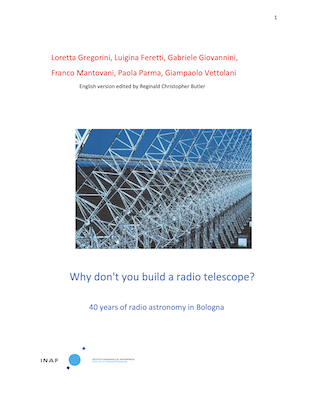
The Institute of Radioastronomy in Italy tells the story of its origins
by Tiziana Venturi (INAF, Istituto di Radioastronomia, Italy)

di Radioastronomia.
The Institute of Radioastronomy recently published a book on its origins, from the very early discussions among a group of young physicists, to the construction of the radio telescopes all the way to the science, technology and computing developments up to the year 2000.
The first conversations on radio astronomy in Italy date back to the end of 1950s, a time when the field was new and full of promises for scientists. A group of young physicists at the University of Bologna started to think of building a radio telescope almost as a joke, as the title of the book suggests, "Why don’t you build a radio telescope? 40 years of radio astronomy in Bologna."
The enthusiasm for this new branch of astronomy shortly led to the birth and growth of international collaborations with colleagues who were already engaged in the construction of radio telescopes throughout Europe, Australia and in India.
The Northern Cross, the transit interferometer located in Medicina operating at 408 MHz, started its operations in the record time of 4 years, and already by the end of 1964 the first catalogue of radio sources at 408 MHz was produced and presented to the community. During its active life, the Northern Cross has provided 3 catalogues of radio sources, and has paved the way to the well-recognised Italian expertise in the area of radio galaxies, galaxy clusters and pulsars. Collaborations and strong friendships among colleagues from all over the world have been built around the Northern Cross.
As the proverb says, appetite comes with eating, and during the 1970s interest in joining the very long baseline interferometry (VLBI) observations started to take hold, and back in 1978 the first plan to have three antennas on the Italian territory operating up to 20-30 GHz was presented at the National Council of Research. We all know that it took much longer to finalise the full project, and in the meantime a lot has happened. The original idea was to have three identical antennas located in Bologna, in Sicily and in Sardinia, but during the process the antenna in Sardinia doubled its diameter to become among the largest dishes in the world operating up to 100 GHz. The interest in VLBI had two sides, astronomical and geodetic, partly because of the geodetic origin itself of some of the VLBI technology, and partly because of the peculiar Italian territory, which is found on a very seismic are, in a point where the African and the Eurasian plates meet.
The 32m-dish in Medicina was the first to join the observations of the newly born European VLBI Network (EVN), in 1985 and Noto followed in 1989. Some of you may remember the episode of the PBS series “The Astronomers” devoted to the study of black holes at milliarsecond scale resolution, where the campaign on 3C84 was followed at each observatory: those were the first network observations with the inclusion of Noto.
Together with the technological developments of VLBI grew the science, and the Institute became a reference for the study of compact steep spectrum radio sources, low power radio galaxies and masers together with many friends and collaborators worldwide.
All this, and much more, is narrated in the book, together with a selection of original documents and pictures, which powerfully bring the reader back to those times. The story of the birth of radio astronomy is the personal story of its founders, too, and of the connection between the enthusiasm of the young scientists and the social environment of the early ‘60s.
The story ends in the year 2000, the idea being that the younger generations will continue to write this wonderful journey of scientific advances, international cooperation and long-lasting friendships.
The book is available online at this link.